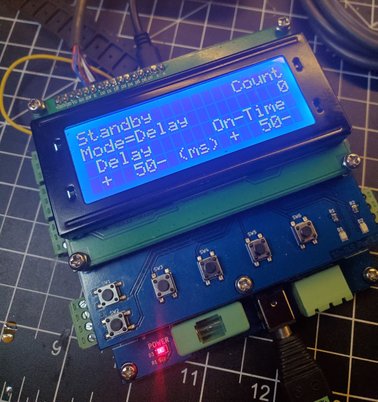Teensy based CNC board
- hairy
- Offline
- New Member
-

- Posts: 10
- Thank you received: 1
Please Log in or Create an account to join the conversation.
- ALittleOffTheRails
-

- Visitor
-

Mesa gives you a turnkey solution, ie you don't need to design or build other boards. I suspect Mesa will be around for a good few more years, so it would seem like a good long term solution.
Scotta is doing a good job with Remora, using existing hardware, and he is quite active in development.
Colorcnc has a cheap fpga board as a starting point; but to get input the board needs modification. Not an issue for myself as I have experience in board level repairs at industry level. This may scare off others.
Allwincnc seems a decent enough project, but I\O is only 3.3v, so voltage translation is required for anything other than 3.3 signals.
In all honestly for those that want a cheap entry to cnc Grbl seems to be popular. Not the best if you want to do threading or anything that requires real time synchronisation.
I don't think many of the Chinese manufacturers will be producing boards that work with Linuxcnc, so there will be a bit of DIY required. So I don't think Linuxcnc will get the same variety of products as the 3D printing scene.
In reality CNC is not cheap, especially if you want to start making chips in metal, more so if you need the rigidity to cut steel, even as a hobby.
Please Log in or Create an account to join the conversation.
- robertspark
- Offline
- Platinum Member
-

- Posts: 915
- Thank you received: 216
Mesa is not that expensive for their hardware..... you can buy the 7i92 for not a lot and add whatever or your own breakout board that will be fast and good. Grbl is probably your solution for cheap and cost effictive cnc... although for a little bit of money 7i92 is a much better solution.
The thing with "cheap" is you are probably not valuing your time effectively ..... sure you may do whatever in your "free" time.... but could you be doing something more productive .....
Attachments:
Please Log in or Create an account to join the conversation.
- hairy
- Offline
- New Member
-

- Posts: 10
- Thank you received: 1
Please Log in or Create an account to join the conversation.
- robertspark
- Offline
- Platinum Member
-

- Posts: 915
- Thank you received: 216
Please Log in or Create an account to join the conversation.
- hairy
- Offline
- New Member
-

- Posts: 10
- Thank you received: 1
Yeah, that's already happening, development of multiple alternative solutions are well underway, like alittleofftherails above well summarized.good luck with your development of a lower cost solution.
Please Log in or Create an account to join the conversation.
- ALittleOffTheRails
-

- Visitor
-

If memory serves me correct, just to buy the matching male & female screw connectors used on a Mesa 7i76 or 7I76E in small quantities would be close to half the price 7i76 alone. Whilst they are many that look similar, finding ones that you can plug right next to each other takes some searching.
Please Log in or Create an account to join the conversation.
- blazini36
- Offline
- Platinum Member
-

- Posts: 972
- Thank you received: 167
What seems to happens with some of these alternative projects is that the interface from low voltage logic, many devices are 3.3 now, to the voltages used on a cnc machine, say 24v, and getting the screw connectors you want in the quantity you want can be a bit on the high side.
If memory serves me correct, just to buy the matching male & female screw connectors used on a Mesa 7i76 or 7I76E in small quantities would be close to half the price 7i76 alone. Whilst they are many that look similar, finding ones that you can plug right next to each other takes some searching.
Not at all sure what you're saying here about voltages. 3.3v IS a logic voltage, 24v is a "field voltage" as Mesa would call it and it's a term I like to use. Even in a 3d printer, the stepper motors are not running at 3.3v. On a Mesa card, it takes or creates a 5v logic voltage that it regulates down to 3.3v and controls an up to 30v field voltage. I make this:
A Teensy has 3.3v IO and has a 5v VIN. That board will take 6-30v and power the Teensy @ 5v and all the IO is whatever 6-30, whatever is supplied.
"Screw connectors" are -like- Phoenix Contact MCV 3.5mm. I say like because they are not PC brand, even on a Mesa card. You can get Chinese ones for pennies but ya gotta buy enough to make shipping worth it. Mesa uses alot of off brand Chinese components on cards.....which is OK, because they'd cost a hell of alot more if they didn't. I believe being able to put them side by side is a feature of 3.5mm connectors. I usually use 3.71mm IIRC and they don't do this. I have tons of them.
Attachments:
Please Log in or Create an account to join the conversation.
- blazini36
- Offline
- Platinum Member
-

- Posts: 972
- Thank you received: 167
I think your post here is fairly misguided. Not sure who drove the point into "low cost" or "cheap", I doubt that was the original posters point nor was it mine. You seem to have this idea that someone is looking to mass manufacture a competitor for a Mesa card or something. When has that ever been the point of any of these projects in LinuxCNC. People spend a whole lot of time doing crazy ass things around here for.....reasons.good luck with your development of a lower cost solution.
the pc industry I believe has capitalized / leveraged future sales on projected future sales volume.... you could try the Chinese model too of volume without post sale support too to cut down on costs
... Mesa hardware is again not very expensive especially if you value your time at $50/hr or even $5/hr and it's likely to take more than a few hours to develop a teensy alternative + there is obviously going to be some hardware cost in actually manufacturing your solution.... + Mesa hardware is well supported..... ask a question here and I'm sure you'll get an answer to any obscure hardware combination you can ask or firmware mod you require).
If you are bored and need a challenge then go ahead as I'm sure that others will benefit from your efforts.....
If you want to develop an alternative solution for the market then great too....
My point was.... don't just chase "cheap" as if you have a one off solution (or a small volume) sometimes its just better to buy a developed and well supported solution., than reinvent the wheel because you think you will save a bit of money and value your 2 or 3 months of product development time as zero cost.
Personally I make alot of obscure things that mostly see industrial use but stick to a certain form factor. If I need 4 decent encoder channels but only a few inputs or outputs, what does that Mesa solution look like? it consists of at least 2 Mesa cards neither of which is 1/2 used. I gotta stuff all that into a box.
If there was a Teensy firmware based on something like hm2 where modules can be loaded based on the IO on the carrier board it opens alot of possibilities up to someone with reasonable electronic design skills. It's not that Mesa stuff is "proprietary" it's that Mesa stuff is "off the shelf". for people building a mill or a lathe you really can't go wrong with Mesa stuff, but you can do alot more than that with LinuxCNC and like i said a Mesa setup could wind up being several cards just because none of which is perfectly suitable by itself.
The Teensy isn't a good candidate because it's "cheap". A Teensy 4.1 costs more than a Spartan 6 FPGA. The point it that it's accessible. Don't make the mistake of thinking a Teensy is just an overpriced Arduino either. The NXP chip on a Teensy has hardware encoder counters that when exposed are extremely capable. The FPGA will always have a leg up by running parallel soft cores, but the CPU on a Teensy 4.x would probably stomp an awful lot of commercial MCU based motion control devices.
It's kinda of a shame that the Machinekit thing split out of LinuxCNC. Those were the guys that got this kinda stuff. Unfortunately they had too many big plans and not enough people to keep it going. It woulda been nice if some of that maker spirit stuck with LinuxCNC
Please Log in or Create an account to join the conversation.
- robertspark
- Offline
- Platinum Member
-

- Posts: 915
- Thank you received: 216
Attachments:
Please Log in or Create an account to join the conversation.




